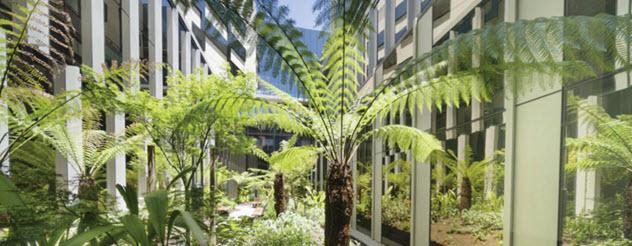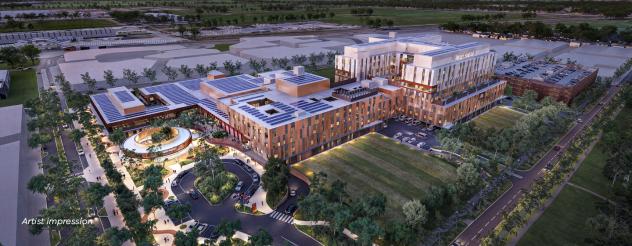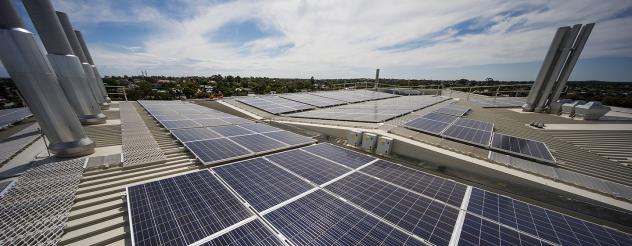
- Home
- How do we design health infrastructure for sustainability?
 Our Environmental Sustainability Manager, Tiernan Humphrys, recently spoke on a panel at the event Public and Private in Tandem, Towards Sustainable and Digital Assets.
Our Environmental Sustainability Manager, Tiernan Humphrys, recently spoke on a panel at the event Public and Private in Tandem, Towards Sustainable and Digital Assets.
The expert panel explored the themes of decarbonisation, digital transformation, and emerging technologies.
We caught up with Tiernan after the event to discuss our environmental sustainability approach to health infrastructure.
The Victorian Health Building Authority (VHBA) is responsible for the planning and delivery of the Victorian Government’s multi-billion-dollar health infrastructure program. What are we doing to ensure what we are building now will be sustainable and climate resilient?
‘Hospitals are energy intensive due to the nature of services they provide, and the amount of floor space that is heated and cooled to tightly controlled temperatures. In 2021-22 we used some 5.6 petajoules of energy, with a rough 50-50 split for electricity and gas. On average 1.4 gigajoules of energy per square metre, or about 220 kilograms of carbon per square metre.
Due to the age of many public hospitals in Victoria, there are significant energy efficiency opportunities. In the past five to six years we have invested some $30 million in energy efficiency and solar, and there is plenty more investment to come.
Some of the things we are doing in the capital works space include:
- specification of what we expect to see as business as usual on all projects
- allocation of 2.5 per cent of the total construction cost to invest in sustainability initiatives above standard practice
- setting design targets of at least five-stars under Victoria’s National Australian Built Environment Rating Scheme (NABERS) for all new public hospitals and major expansions
- requiring air tightness testing on our buildings
- increased focus on electrification
- employing sustainability consultants on all our projects.
An example is the $7 million energy performance contract at Peninsula Health where we installed over 4,500 LED lights, replaced ageing steam infrastructure, installed efficient plant, and upgraded building controls. This reduced carbon by over 20 per cent and paid for itself in five years.'
Electrification
‘Electrification is a big focus for us and a major way we are designing and building sustainable facilities with NABERS design targets being a real game changer. Building a hospital to five-star all-electric would use around 10 gigawatt hours of electricity a year. If it was built to three-star, the average performance of electricity use would double to over 21 gigawatt hours.
In addition, we already require all our health facilities below 10,000 square meters to be all-electric and are doing this for ambulance stations, early parenting centres and other community health facilities.
We are also beginning to see all-electric options as part of the plans for our new major hospitals. The $900 million new Melton Hospital will be Victoria’s first all-electric hospital. This project was, I like to think, the catalyst for the new policy in Victoria’s gas substitution roadmap for government business cases for new public infrastructure required to include an all-electric option!
This really supports the Victorian Government’s commitment for all electricity used by publicly funded operations, including public hospitals, to be from 100 per cent renewable sources from 2025.
And there’s also solar, which is a real opportunity in our new and existing buildings. We now have 149 arrays installed with a capacity of 12 megawatt-peak, and a further 44 arrays with a capacity of nearly 4 megawatt-peak funded and being installed. This means that more of our hospitals are generating some of their own electricity, rather than sourcing it from the grid.'
Data
Having good environmental data must be key to managing the performance of assets. Can you tell us about what data you collect and how you use it to drive environmental performance?
‘Good data is essential – it’s a cliché but it’s true – you can’t manage what you don’t measure. The availability of data has increased significantly over the last 10 years. I remember asking suppliers for electronic data when I first started and being emailed a PDF copy of the bill!
Now the issue is having too much data and being able to manage it - we collect data from 1,500 electricity meters, 700 gas meters, 1,400 water meters and generation data from over 150 solar arrays. And while this is all valuable, data is only as good as how you use it.
We use data for:
- building the business case for investment
- completing annual energy and water NABERS ratings for our 140 hospitals
- informing benchmarks for our capital works program
- reporting internally on key metrics such as energy intensity, carbon emissions and cost
- reporting publicly on our performance through our annual report.
If you’re collecting and using data, here are a few of my data rules:
- if you ask someone to give you data, offer insights from that data in return
- see data for the value it provides, not for the cost of collecting it
- collect the level of data you need – too much data can be overwhelming if you don’t have the resources or systems to manage it
- source electronic data direct from your suppliers – reduce manual entry effort and errors as much as you can
- manage data throughout the year, not the week before you need to do your reporting.’
Learn more about our guidelines for sustainability in capital works, all-electric new Melton Hospital, Peninsula Health energy performance contract and regional health solar program.
Related content

22 October 2021
Guidelines for sustainability in capital works
Our sustainability guidelines provide advice and guidance on how to build sustainable and resilient buildings. They are relevant to all stakeholders involved in the design, construction and ...
06 March 2025
New Melton Hospital
The Victorian Government has committed more than $900 million to deliver a new Melton Hospital.
02 October 2023
Sustainable healthcare for all Victorians
See how the Victorian Health Building Authority is making significant progress in reducing environmental impacts.
25 May 2020
Peninsula Health - Energy performance contract
Peninsula Health’s energy performance contract is a sustainability initiative that has significantly reduced energy and water usage across four of their hospitals and healthcare facilities. ...
15 August 2022



